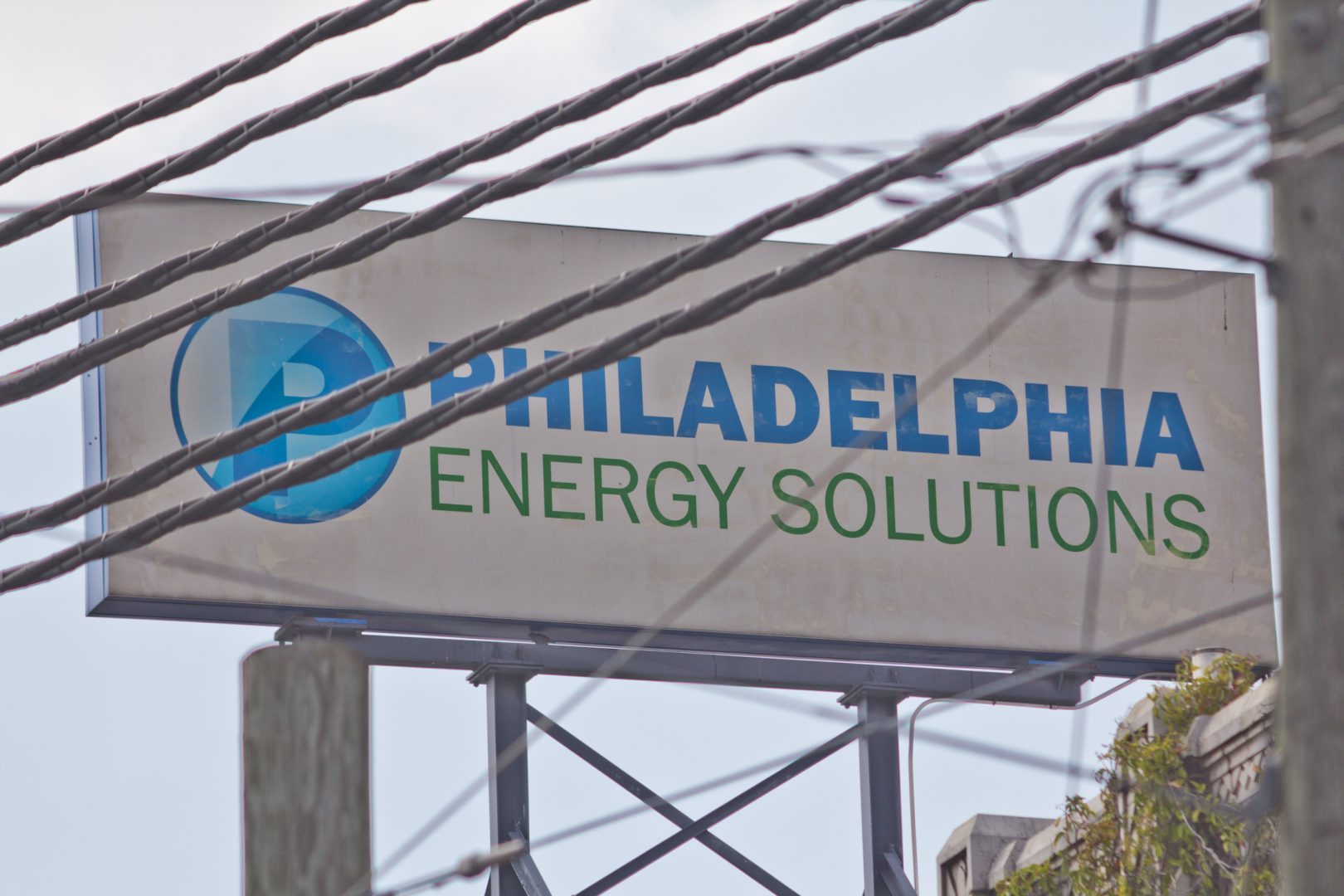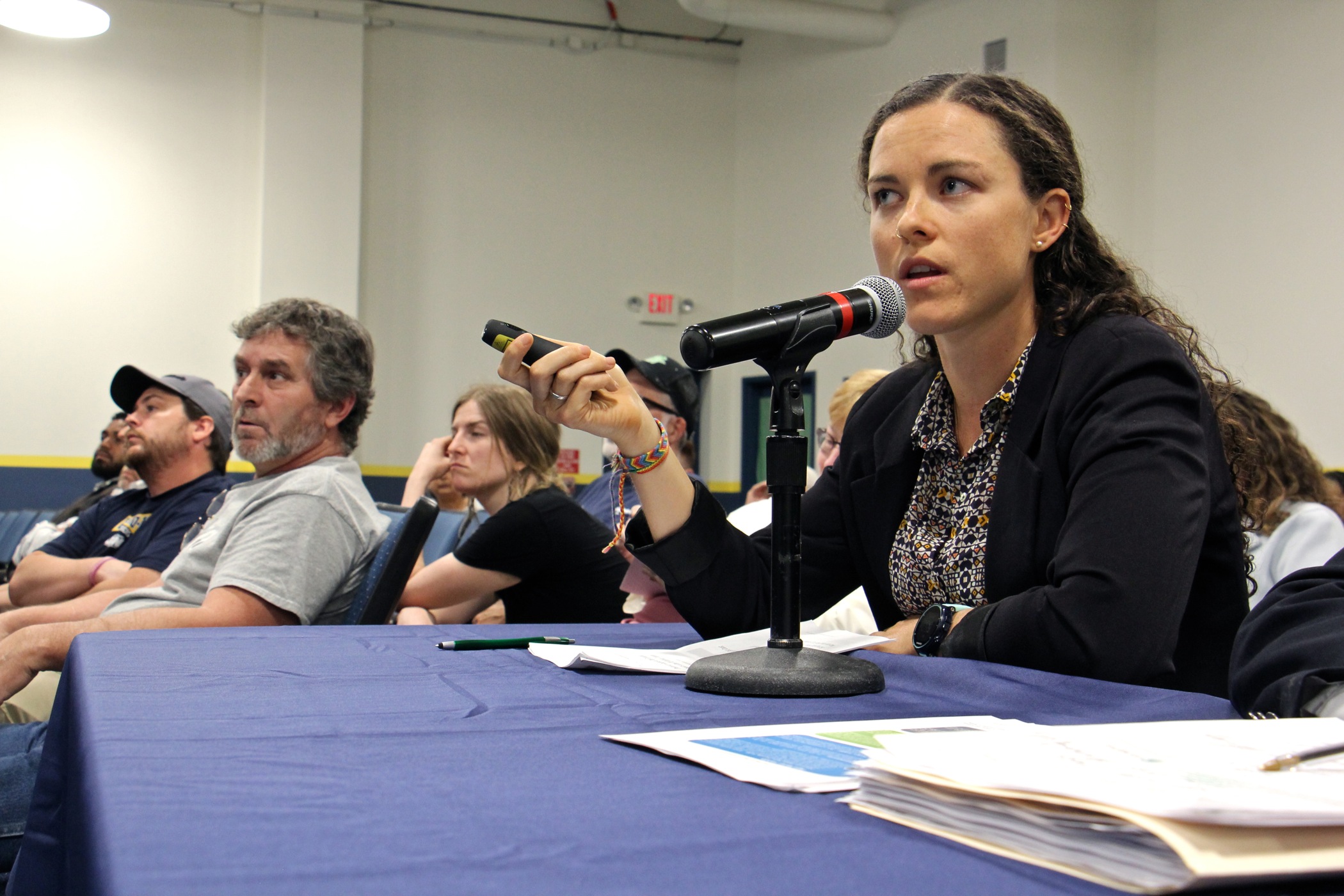
Philadelphia Energy Solutions refinery in South Philadelphia. Workers are in the process of neutralizing a highly toxic substance as part of a shut down.
Kimberly Paynter / WHYY


Philadelphia Energy Solutions refinery in South Philadelphia. Workers are in the process of neutralizing a highly toxic substance as part of a shut down.
Kimberly Paynter / WHYY

Kimberly Paynter / WHYY
Philadelphia Energy Solutions refinery in South Philadelphia. Workers are in the process of neutralizing a highly toxic substance as part of a shut down.

Emma Lee / WHYY
Refinery employee Shawn Tolomeo argues that the Philadelphia Energy Solutions property in South Philadelphia should remain a refinery.
Infuriating. Unfair. Repulsive. Those are some of the printable words used by former employees of Philadelphia Energy Solutions to describe their thoughts about the news that company executives got about $4.5 million in bonuses before PES filed for Chapter 11 bankruptcy.
A group of the workers gathered at a Philadelphia Refinery Advisory Group meeting on Monday night. They are among the more than 1,000 employees who were laid off with no severance pay or extended medical benefits by the end of August, after working at the refinery complex for years. Some have not been able to access their pensions, according to their union.
Meanwhile, PES chief executive officer Mark Smith, in the job since August 2018, received a $1.545 million retention bonus, according to documents filed with U.S. Bankruptcy Court in Wilmington, as first reported by Reuters.
“Big bank for just a year,” said Ryan O’Callaghan, who headed United Steelworkers local at the refinery and is now out of job himself. “They stuffed their pockets while they walked — and had already walked — people out the gate, and intended to walk the others out the gate, without any compensation for a life’s time of work. It’s infuriating.”
O’Callaghan said most union members are not that surprised about the executives getting paid: “These corporations, they feather their own beds all the time.” But union members are shocked about the amount, he said.
“It’s a tough amount to swallow,” said Robert Campbell, who worked at the South Philadelphia refinery for more than 20 years. “I wish they would have shared their bonuses more fairly with everybody who worked there. A lot of guys put their blood, sweat and tears to that place, and they were crushed that they lost their jobs.”
The bonuses were paid on July 5, exactly two weeks after the explosion and fire that ultimately shut the facility down, and just weeks before the company filed for Chapter 11, according to documents filed with the bankruptcy court. Others receiving bonuses of over $300,000 include executive vice president John McShane; chief financial officer Rachel Celiberti, who also received an extra $75,000 spot bonus; deputy staff attorney Anthony Lagreca, who also got a $50,000 spot bonus; and refinery manager Daniel Statile.
Among other payments that bothered former refinery workers: those to Billy Goodhart, a human resources consultant who received $363,340 in 10 months working for the refinery while living in Texas — $295,646 for professional services, $56,651 for travel expenses, and $10,043 for other expenses.
“It’s upsetting he was a self-proclaimed union breaker and earned so much for it,” Campbell said.
Philadelphia Energy Solutions did not respond Tuesday to a request for comment.
In a fully operational year before both the fire and the bankruptcy filing, the PES complex provided $2.1 billion in economic activity and supported 6,300 jobs, according to a report presented Monday night to the Refinery Advisory Group by Gabrielle Connor, senior analyst at Econsult Solutions Inc. That’s including direct, indirect and induced jobs and activity made possible by the refinery — grocery stores, health and financial services, restaurants, and more.

Emma Lee / WHYY
Data analyst Gabrielle Connor reports that the shutdown of the PES Refinery will have an annual economic impact of $2.1 billion in Philadelphia and cost the city 6,300 jobs.
The direct economic impact for the city in annual expenditures was $1.1 billion, according to the report. The refinery directly employed 1,950 people full time on average annually, with a total annual employee compensation of $237 million. Including indirect and induced jobs, the employee compensation for the city went up to $600 million, Connor said.
Numbers for the Philadelphia metropolitan area and for Pennsylvania were a little bit higher, with $2.3 billion in total economic impact across both.
The total estimated tax impact for Philadelphia was $33.2 million, with an additional $30 million in state taxes, according to the report. That included income, business, sales and use, property, and use and occupancy taxes.
Refinery workers did not openly comment on the executive bonuses while they talked about the regional economic benefits that would be lost if the 150-year-old complex permanently shut down.
“Guess what keeps changing here?” asked Kendra Brooks, who identified herself as a “tree-hugging, union-loving” activist. “The corporation. People … they make wealth, get money off of our city, and they’re gone. And we’re still left to hold the bag.”
Activists also said the numbers shared did not include health and environmental costs that could be associated with the refinery.
“Funeral costs help the economy, but not in a way that I would wish on anyone,” said John Bergen, a third-generation pastor at Germantown Mennonite Church. “While we’re debating the business benefits of what could happen here, those who truly, really profit from the death in Southwest Philadelphia, they are not in the room — we know that. Their lawyers are off somewhere else, putting money in other people’s hands to determine the future of people in both sides of this room.”

Emma Lee / WHYY
Kendra Brooks urges Refinery Advisory Committee members to consider their grandchildren’s children when deciding what should become of the PES refinery complex.
The market conditions for refineries on the East Coast are not promising, according to a presentation by Phil Hopkins, senior consultant at IHS Markit and director of ECR Consulting in Philadelphia.
According to Hopkins, the demand for refined products in the United States will peak in 2020, with a long gradual decline after that year caused by increased fuel efficiency and wider use of hybrid and electric cars. East Coast refineries are expected to see the steepest decline, due to higher operating costs and competition from refineries in the Midwest, the Caribbean, and Africa.
“Our feeling prior to the fire was that we have five refineries on the East Coast and probably one of those was going to have to close just because it would be hard to compete,” Hopkins said.
Based on the site’s assets, uncertainties and liabilities, including land-use factors related to climate change, Hopkins said potential reuse options for the PES complex are to continue to process oil in spite of the challenges, or to repurpose it for production of biofuels and alternative energy, natural-gas liquids or petrochemicals. The location also could be used for heavy manufacturing or as a warehouse for distribution.
“It has outstanding transportation access. It’s hard to think of any place in the country where you have a 1,400-acre site that’s near two interstates, near an international airport, has easy access to the port and rail access, and pipeline access,” he said.
A group of 23 stakeholders engaged by the Refinery Advisory Group’s business committee arrived at similar conclusions, according to Eliza Klesten Alford, government relations manager at the Sustainable Business Network of Philadelphia.
Their analysis took into consideration the current zoning of the site, the level of remediation needed, market viability, public health and environmental impact, estimated land requirement for other uses, existing infrastructure, and job types available. And it concluded that the site could potentially host alternative-energy and resource-recovery industries, from solar, wind or battery farms to waste recycling or processing plants, port operations or logistics operations, or traditional energy facilities including gas-to-liquids production and storage.
To date, there are two potential buyers of the refinery complex: former PES CEO Phil Rinaldi’s newly formed Philadelphia Energy Industries and Philly-based biofuels company S.G. Preston. Any sale would need bankruptcy court approval.
Philadelphia Managing Director Brian Abernathy, who co-chairs the advisory group, announced a new meeting date, Sept. 25. That session will not include public presentations or comments, but will provide an extra opportunity for residents to offer input before the group starts to prepare a final report, to be presented sometime this fall.
StateImpact Pennsylvania is a collaboration among WITF, WHYY, and the Allegheny Front. Reporters Reid Frazier, Rachel McDevitt and Susan Phillips cover the commonwealth’s energy economy. Read their reports on this site, and hear them on public radio stations across Pennsylvania.
(listed by story count)
StateImpact Pennsylvania is a collaboration among WITF, WHYY, and the Allegheny Front. Reporters Reid Frazier, Rachel McDevitt and Susan Phillips cover the commonwealth’s energy economy. Read their reports on this site, and hear them on public radio stations across Pennsylvania.
Climate Solutions, a collaboration of news organizations, educational institutions and a theater company, uses engagement, education and storytelling to help central Pennsylvanians toward climate change literacy, resilience and adaptation. Our work will amplify how people are finding solutions to the challenges presented by a warming world.